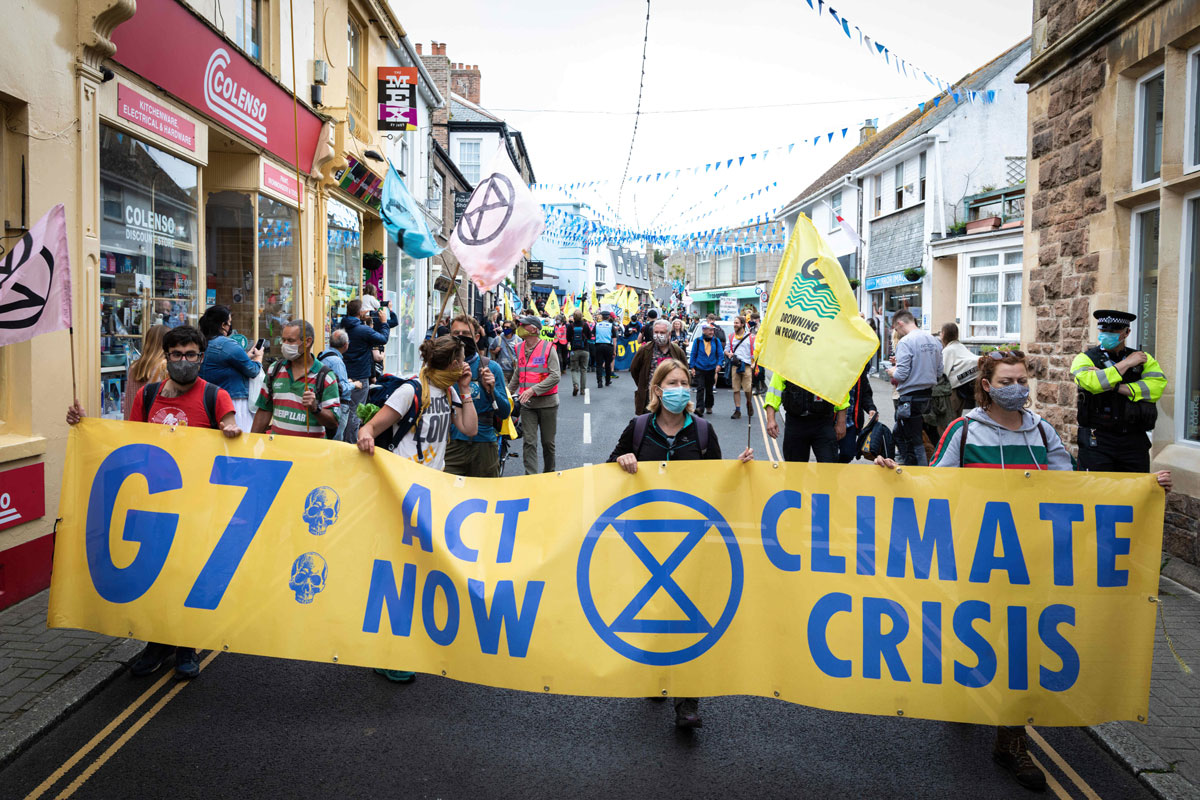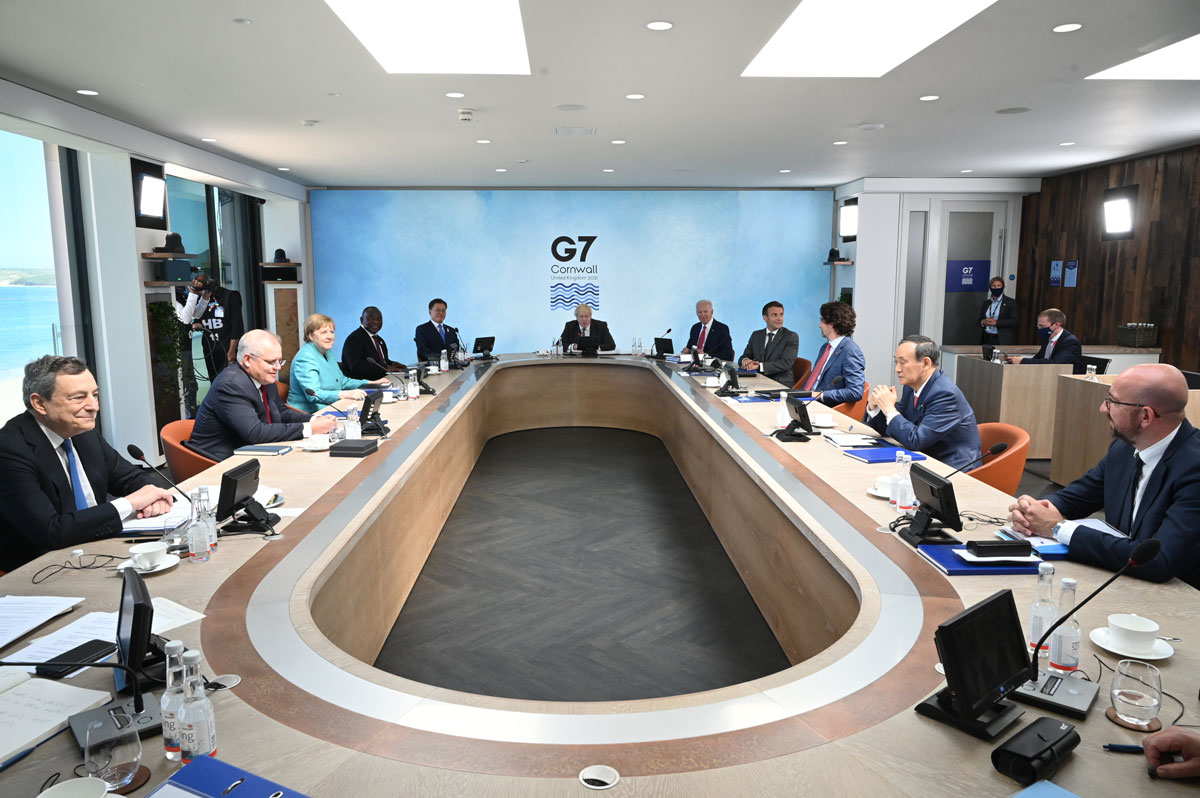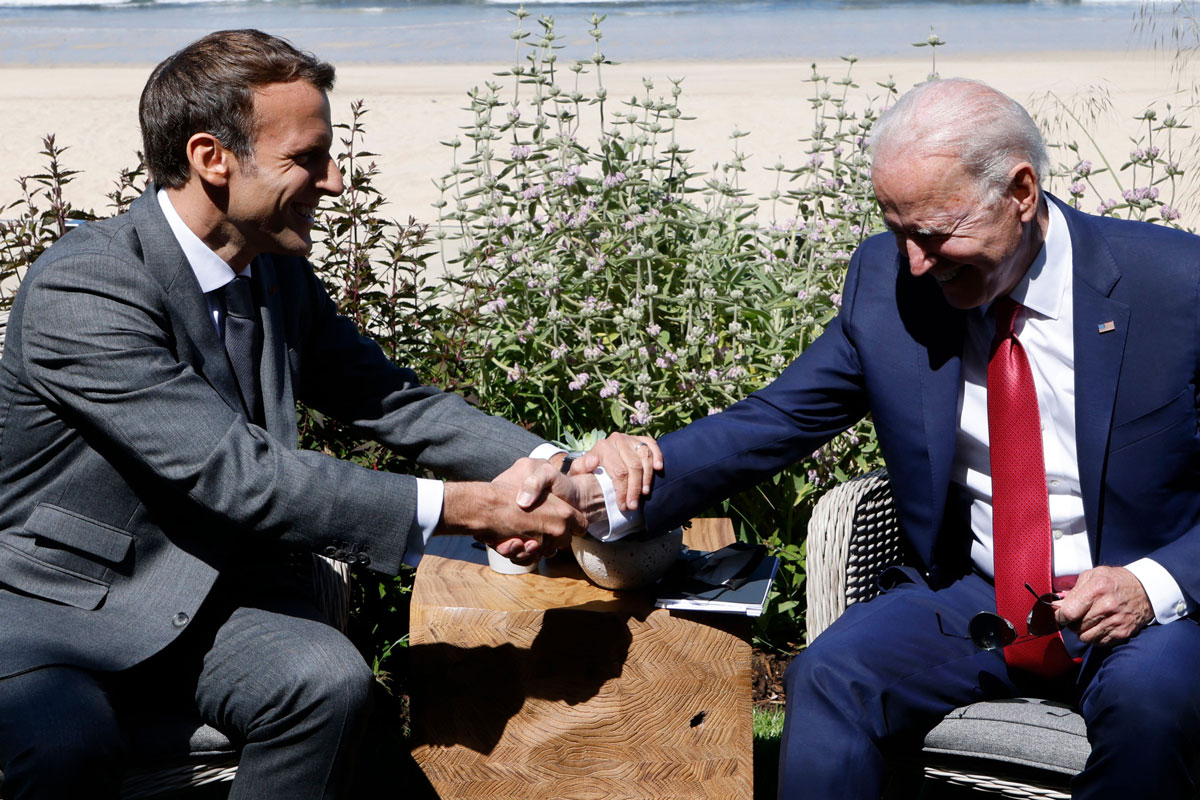G7 leaders facing ‘most important decisions in human history,’ environmentalist says
From CNN’s Laura Smith-Spark

Leaders at the G7 face some of the most important decisions in human history as they look to tackle climate change, esteemed British naturalist and broadcaster David Attenborough has said.
Attenborough is addressing the G7 leaders today, the final day of the summit.
“The natural world today is greatly diminished. That is undeniable,” he said ahead of the session, according to PA.
“Our climate is warming fast. That is beyond doubt. Our societies and nations are unequal and that is sadly plain to see.
“But the question science forces us to address specifically in 2021 is whether as a result of these intertwined facts we are on the verge of destabilising the entire planet?
“If that is so, then the decisions we make this decade — in particular the decisions made by the most economically advanced nations — are the most important in human history.”
The climate crisis has been a key theme at this year’s G7 summit, and hopes are high that G7 leaders will make significant environmental commitments as it wraps up.
UK Prime Minister Boris Johnson tweeted Sunday that the G7 leaders had an “unprecedented opportunity to drive a global Green Industrial Revolution” and transform people’s lives.
“There is a direct relationship between reducing emissions, restoring nature, creating jobs and ensuring long-term economic growth,” he said.
Crunch time for climate as G7 leaders set tone for crucial decade
Analysis by Angela Dewan in Falmouth, England

Never before has climate change been so prominent on a G7 agenda. But equally, the world has never been at such a critical point to act on this existential threat.
Despite the Covid-19 pandemic that brought much of the global economy to a standstill in spurts over the past 18 months, carbon emissions are still at an all-time high.
The US, UK and EU in April all lifted their targets to slash carbon and other greenhouse gas emissions by 2030 — scientists say that emissions need to be halved over this decade to keep global warming from breaking the threshold of 1.5 degrees Celsius above pre-industrial levels. We are already 1.2 degrees Celsius from that baseline.
Pressure is mounting on Canada and Japan to increase their pledges, which fall far behind those of their G7 allies.
It’s not clear if they will, or if anything concrete will even emerge today as leaders hold their climate change session later this morning.
Japan has already agreed to stop using old, inefficient coal-fired power plants, but it remains heavily reliant on coal in its energy mix, particularly as it softened on nuclear power after the Fukushima disaster. Canada’s economy is still buoyed by oil and gas and, while it also raised its pledge in April, scientists and climate activists say it’s nowhere near in line with 1.5C.
G7 meetings tend to end with communiqués that set a tone, a direction. That’s important — the world will need to get on the same page if the COP26 climate conference in Glasgow later this year is to be a success and to end in decision that will prevent anything more than an extra 0.3 degrees C of warming. Going beyond that will put millions more people at risk of extreme weather events and their impacts, like heatwaves and drought, and will all but wipe out coral reefs that sustain vital ecosystems, scientists project.
Still, there are positive signs and clear momentum.
Before the leaders’ summit, environment and energy ministers agreed to stop funding coal-fired power plants in developing countries by the end of this year, and to ensure 30% of land and sea in their own countries are protected, in line with scientists’ advice on how ecosystems will need to contribute to climate change mitigation.
Finance ministers agreed to move toward a system of mandatory reporting for listed companies and financial institutions to disclose their climate-related risks — in what is likely a stepping-stone to more concrete agreement at the COP26 conference in November.
And language from leaders that they will keep their policies in line with 1.5C suggests fossil fuel companies may soon have to prove their activities are in line with that goal — they are clearly not.
It’s crunch time for climate, and the direction G7 leaders set today for this crucial decade will be among the most important in history for the future of our planet.
The rules Biden should follow when he meets the Queen
Analysis from CNN’s Max Foster and Lauren Said-Moorhouse

A meeting with the monarch can be intimidating … even if you are a world leader. The Queen has met nearly every US President to take office during her lengthy reign.
No doubt keen to make a good impression on his first trip abroad, US President Joe Biden will probably want to follow the established conventions for his one-on-one with the 95-year-old monarch. Here’s a quick rundown of the royal rules of engagement.
What you should do
- There is no obligatory code of conduct to abide by when greeting royals, according to the family’s website. However, it does acknowledge that some may choose to observe “traditional forms.”
- Basically, that means the Queen doesn’t expect people to bow to her, though many do so anyway. For men, that could be a gentle dip of the head, while women can opt for a small curtsy. You could also add a handshake (if she offers first!) but, either way, the secret is not to overdo it.
- When meeting the Queen, tradition dictates that she speaks first. In response, the correct form is to first address her as “Your Majesty” before swapping to “Ma’am.” And in case you were wondering, there is a preference in pronunciation here — it should be “Ma’am” to rhyme with “jam.” Whatever you do, don’t use her first name.
- Although royal protocols have relaxed in more recent years, a top tip is to take your cue from the Queen. If she walks, you follow; if she sits, you can too; and if dinner’s involved, best wait for her to start before tucking in. We all remember Donald Trump’s gaffe when he blocked the Queen and then walked ahead of her during his visit to Windsor.
What you should avoid
- Don’t be late. According to Debrett’s, the leading authority on British etiquette, “It is correct for everyone to arrive before the royal personage and protocol rules that no guest should leave an event before a member of the Royal Family, except in special circumstances when prior permission should be obtained.” If you do need to duck out, make sure to seek permission through a private secretary first.
- It may seem obvious but don’t touch the Queen without her consent. She initiates any contact — and that’s a handshake at most. In 2017, the then-Canadian Governor General David Johnston made headlines when he placed his hand on the Queen’s elbow during a visit to Canada House in London. Johnston later said he was simply “anxious” about slippery carpet and chose to forgo convention “to be sure that there was no stumble.”
- And probably best to avoid going in for a hug. It was quite a frenzy in 2009 when then-first lady Michelle Obama instinctively embraced the Queen (who sort of reciprocated). The British media had a field day, with conflicting observations about the moment. That said, Obama recalled a subsequent visit to Windsor Castle in 2016, when she was fretting over royal protocol but the monarch shrugged it off, declaring it “all rubbish.”
Read more here.
Biden is meeting with Queen Elizabeth today at Windsor Castle. Here’s what to expect.
From CNN’s Max Foster, Lauren Said-Moorhouse and Rob Picheta
Britain’s Queen Elizabeth II will welcome US President Joe Biden to Windsor Castle today.
The monarch’s meeting with Biden and first lady Jill Biden comes during the President’s visit to the United Kingdom for the G7 summit, his first trip abroad since taking office.
It will also be the Queen’s first major meeting with a world leader since the death of her husband, Prince Philip, in April, and comes after a year in which most of her in-person engagements were shelved because of the coronavirus pandemic.
Over the course of her reign, the 95-year-old monarch has met with every US President except Lyndon Johnson. In recent years she has curtailed her international travel, making visits with world leaders less common.
Biden is in for quite a treat when he and his wife, “Jill from Philly,” stop by Windsor Castle Sunday.
To welcome the 46th President, Elizabeth is treating him to an honor guard formed of the Grenadier Guards in the castle’s famous quad, Buckingham Palace has announced. The guards — one of the British Army’s longest-serving units — will give a Royal Salute, and the US National Anthem will be played.
The Queen has hosted four other presidents at Windsor: Trump in 2018; Obama in 2016; George W. Bush in 2008; and Reagan back in 1982.
The President will then inspect the troops before rejoining the Queen and first lady to watch the military march-past. Afterward, the group will head into the castle for tea. During our chat with Prince Edward, he discussed the opportunity Biden has in meeting his mother and how others have reacted to spending time with her.
“When you meet somebody who’s had that level of personal experience and knowledge, it’s, I mean, sometimes, it’s funny and can slightly over-awe some people,” the 57-year-old mused. “And I think most people can leave wishing that they’d had a little bit longer. That’s usually the response — just so would’ve liked to have had a little bit longer, because that was fascinating.”
Ahead of the weekend’s big meeting, the royals undertook something of a charm offensiveat the G7 in Cornwall. The Queen, Prince Charles and Camilla, as well as William and Catherine, descended upon the summit for a reception at the world-famous Eden Project, a striking collection of biomes, one of which is home to the largest indoor rainforest on Earth.
Biden and the Queen have been in touch in recent months. The Queen sent a private congratulatory message ahead of his inauguration in January, a royal source told CNN at the time. And earlier this year, the Bidens sent condolences to the Queen, the royal family and the United Kingdom after Philip’s death.
The final day of the G7 summit kicks off today. Here are key things to know about the gathering.
From CNN’s Paul LeBlanc

The third and final day of the 2021 G7 summit will take place today. Over the last couple of days, the leaders of some of the world’s most advanced economies have gathered in Cornwall, England, to discuss coronavirus, the global economic recovery, China and other key topics.
Here’s what you need to know about the summit:
The G7 is shorthand for Group of Seven, an organization of leaders from some of the world’s largest economies: Canada, France, Germany, Italy, Japan, the United Kingdom and the United States.
Russia was indefinitely suspended from the group — which was at the time known as the G8 — in 2014 after the majority of member countries allied against its annexation of Crimea.
Members of the G7 meet each year for a summit to discuss global issues, such as international security and the world economy, and coordinate policy. This year, recovery from the Covid-19 pandemic is expected to be a big topic.
In a statement ahead of the summit, UK Prime Minister Boris Johnson said he would urge his fellow G7 leaders to make concrete commitments to vaccinate the world, as well as give support to the “Global Pandemic Radar” — a new global surveillance system intended to protect immunization programs.
The group has often produced decisions with global consequences.
Ahead of this year’s summit, for instance, G7 finance ministers agreed to back a global minimum tax of at least 15% on multinational companies. The G7 group also agreed that the biggest companies should pay tax where they generate sales, and not just where they have a physical presence.
The meetings began as the “Library Group,” founded in the 1970s by then-US Treasury Secretary George Shultz.
Finance ministers of the US, France, Germany and the UK met for informal “fireside chats” to try to stabilize currency turbulence.
Japan joined soon after and, in 1975 — with two of the original participants having by then become French president and German president — the meetings were turned into gatherings of heads of state and government.
Canada and Italy soon joined and they became known as the Group of Seven.
Read more about the G7 here.
Biden causes sighs of relief among world leaders
From CNN’s Kevin Liptak, Jeff Zeleny, Phil Mattingly and Kaitlan Collins

When former US President Donald Trump used his elbows at international summits, it was to throw them — on trade, on Russia and, once, they helped him remove the Montenegrin prime minister from his path to a photo-op.
His successor Joe Biden used his elbows differently this week. Arriving to his first global summit, he crooked his arm to extend pandemic-era greetings to a group of leaders who no longer have to tiptoe around a truculent and often angry American president.
Officials attending this week’s Group of 7 summit on the Cornish coast in England are emerging shell-shocked after four years dealing with a US president who often appeared intent on injecting animosity into their gatherings. In front of cameras and behind-the-scenes this weekend, officials said the abrasive interjections and lengthy tangents Trump brought to world summits were absent, replaced by a more businesslike and predictable agenda, including on areas of serious disagreement like China.
Asked alongside Biden on Saturday whether the United States was back, French President Emmanuel Macron answered yes.
“Definitely,” he said, waves crashing in Carbis Bay in the background.
Even the special guest at a Friday night reception took note of the new vibe.
“Are you supposed to be looking as if you’re enjoying yourself?” quipped Britain’s Queen Elizabeth, who later was pictured in friendly conversation with Biden and his wife outside a futuristic biosphere, her son Prince Charles and his wife Camilla clutching drinks in the background.
A more conventional presence: During their first session on Friday afternoon, held in front of a picture window at a seaside resort, the world leaders took turns speaking about efforts to contain the pandemic, according to officials familiar with the talks. Biden, seated between British Prime Minister Boris Johnson and Canada’s Justin Trudeau, appeared prepared, according to one European official, describing his administration’s recent purchase of Pfizer doses as a major gesture meant to bring other countries along.
A senior administration official said the first session was meant to highlight areas of agreement. A second session on Saturday proved more divisive as world leaders aired serious differences over how best to approach China.
The disagreements, aired during a session that at one point became so sensitive that all internet was shut off to the room, pitted European nations against the United States, Britain and Canada, who urged stronger action against China for its authoritarian practices, including forced labor practices in western Xinjiang province.
At one point, Biden made a forceful call to other leaders about vocally calling out China’s anti-democratic practices, officials said, emphasizing the need to take action.
Still, though the leaders disagreed, the session was marked by new respect among the leaders after four years of tension under Trump.
Read the full story here.
